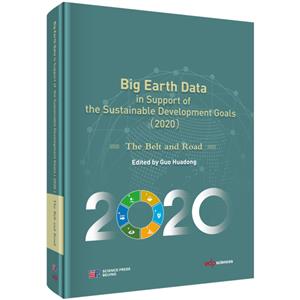-
>
公路車寶典(ZINN的公路車維修與保養秘籍)
-
>
晶體管電路設計(下)
-
>
基于個性化設計策略的智能交通系統關鍵技術
-
>
花樣百出:貴州少數民族圖案填色
-
>
山東教育出版社有限公司技術轉移與技術創新歷史叢書中國高等技術教育的蘇化(1949—1961)以北京地區為中心
-
>
鐵路機車概要.交流傳動內燃.電力機車
-
>
利維坦的道德困境:早期現代政治哲學的問題與脈絡
地球大數據支撐可持續發展目標報告(2020):“一帶一路”篇(英文版) 版權信息
- ISBN:9787030675262
- 條形碼:9787030675262 ; 978-7-03-067526-2
- 裝幀:一般膠版紙
- 冊數:暫無
- 重量:暫無
- 所屬分類:>
地球大數據支撐可持續發展目標報告(2020):“一帶一路”篇(英文版) 內容簡介
《地球大數據支撐可持續發展目標報告(2020):“一帶一路”篇》圍繞零饑餓(SDG2)、清潔飲水和衛生設施(SDG6)、可持續城市和社區(SDG11)、氣候行動(SDG13)、水下生物(SDG14)和陸地生物(SDG15)6個可持續發展目標(SDGs)所開展的44個案例研究、指標建設和可持續發展狀態評估,展示了典型地區、國家、區域以及優選四個尺度在數據產品、方法模型和決策支持方面對相關SDGs及其指標進行的研究和監測評估成果,包括43套數據產品、25種方法模型和30個決策支持結果。這些案例展現了中國利用科技創新推動落實聯合國“2030年可持續發展議程”的探索和實踐,充分揭示了地球大數據技術對監測評估可持續發展目標的應用價值和廣闊前景,開拓了在聯合國技術促進機制框架下利用大數據、人工智能等優選技術方法支撐“2030年可持續發展議程”落實的新途徑和新方法,為各國加強“2030年可持續發展議程”落實的監測評估提供借鑒。
地球大數據支撐可持續發展目標報告(2020):“一帶一路”篇(英文版) 目錄
Foreword i
Preface v
Executive Summary ix
List of Cases on Big Earth Data for SDGs xv
Chapter 1 Introduction
Challenges to implementing the SDGs / 2
Big Earth Data / 3
Big Earth Data in Support of SDGs / 4
Chapter 2 SDG 2 Zero Hunger
Background / 8
Main Contributions / 9
Case Study / 11
Spatial distribution of classes of farmland size and agricultural productivity in Zambia / 11
Monitoring desert locusts in Asia and Africa / 18
Spatiotemporal patterns of rice paddy dynamics on the Indochina Peninsula / 25
Cultivated land productivity dataset and its application in Northeast Eurasia / 32
Ethiopian wheat production potential / 40
Capacity building contributing to food security governance in Mozambique / 46
Summary / 55
Chapter 3 SDG 6 Clean Water and Sanitation
Background / 58
Main Contributions / 59
Case Study / 60
Spatial and temporal patterns of surface water clarity in the countries involved in the Belt and Road Initiative / 60
Crop water productivity assessment of a representative irrigation district in Morocco / 67
Water-use eff iciency in Central Asia / 74
Water-use eff iciency in the Lancang-Mekong River Basin / 81
Changes in water bodies in Ramsar sites / 90
Summary / 97
Chapter 4 SDG 11 Sustainable Cities and Communities
Background / 100
Main Contributions / 101
Case Study / 103
Road network changes and road connectivity assessment in the 65 countries in Asia, Europe and Africa / 103
Analyzing rural accessibility along the China-Pakistan Railway / 113
High-resolution urban impervious surface mapping for global urbanization assessment / 119
Urban land use eff iciency and sustainability analysis for cities in Asia, Europe and Africa / 125
Assessment of land use changes in global large cities / 133
Study on spatial and temporal distribution and protection countermeasures of cultural heritage in Asia, Europe and Africa / 140
Human disturbance monitoring and integrated pressure analysis in World Natural Heritage sites in Asia, Europe and Africa / 151
Summary / 159
Chapter 5 SDG 13 Climate Action
Background / 162
Main Contributions / 163
Case Study / 165
Natural disaster impact evaluation in Asia, Africa, Europe and Oceania, 2015-2019 / 165
Global burned area distribution and changes / 174
Factors and temporal variation of emissions from dust sources in Central Asia over the past 40 years / 179
Global forest carbon budget and climate change / 185
Risk assessment of freeze-thaw disasters in High Mountain Asia / 191
Contributing factors and growth trend analysis for the desert locust upsurge in early 2020 / 197
Evaluation of navigation capacity in the Northeast Passage / 203
Meteorological drought monitoring over arid Central Asia / 209
Summary / 216
Chapter 6 SDG 14 Life Below Water
Background / 220
Main Contributions / 221
Case Study / 223
Eutrophication assessment of the South China Sea and surrounding waters / 223
Spatiotemporal patterns of coastal aquaculture ponds on the Indochina Peninsula and their impact on offshore chlorophyll-a concentration / 232
Monitoring changes in water environments in the ocean around the Port of Colombo / 238
Monitoring the extent and dynamic change in mangrove forests of some coastal countries / 244
Conservation and utilization of the coastline / 251
Summary / 258
Chapter 7 SDG 15 Life on Land
Background / 262
Main Contributions / 264
Case Study / 266
Global/regional forest cover (2019) / 266
Assessment of vulnerability in protected areas of the “Three Seas and One Lake” international basins, 2001-2015 / 271
Spatiotemporal dynamics of forest cover in Southeast Asia / 276
Global Land Degradation Neutrality (LDN) progress report / 284
Monitoring and assessing land degradation in five Central Asian countries / 289
Assessment of grassland degradation in Mediterranean Africa / 296
Dynamic monitoring and control measures of land degradation and restoration in Mongolia / 304
Time-series monitoring and decision support of the Mountain Green Cover Index in the Belt and Road Economic Corridors / 311
Assessment of forest changes in Asian elephant habitats / 319
Monitoring forest type of Amur tiger habitat / 325
Global land cover changes in the past 20 years / 331
Potential productivity and water use eff iciency for global terrestrial ecosystems / 339
Global assessment of the impact of population and climate change on the ecosystem material supply capacity of drylands / 347
Summary / 355
Chapter 8 Summary and Prospects / 358
References / 362
Acronyms / 381
地球大數據支撐可持續發展目標報告(2020):“一帶一路”篇(英文版) 節選
2 Challenges to implementing the SDGs 3 Big Earth Data 4 Big Earth Data in Support of SDGs Chapter 1 Introduction In 2015, the United Nations Sustainable Development Summit adopted a plan of action titled Transforming Our World: The 2030 Agenda for Sustainable Development, which proposed 17SDGs covering economic, social and environmental aspects. These goals represent the direction of national development and international cooperation needed to address the world’s mostpressing environmental and societal issues. In the almost f ive years since the Agenda’s adoption,the monitoring and evaluation of its implementation have been constrained by a lack of data,varying capacities, and indicators that are both intertwined and mutually restrictive. Scientific and technological innovation is a solution to this pressing issue, and this report focuses specif icallyon “Big Earth Data”, a set of technologies and methods being practiced at the intersection of big data and Earth observation. The CAS Big Earth Data Science Engineering Project (CASEarth)has released annual scientific, evidence-based monitoring results for six SDGs — SDG 2 (Zero Hunger), SDG 6 (Clean Water and Sanitation), SDG 11 (Sustainable Cities and Communities),SDG 13 (Climate Action), SDG 14 (Life Below Water), and SDG 15 (Life on Land) — by drawing on Big Earth Data’s strengths in multi-scale, near-real-time processing and system integration. This is a concrete contribution to implementing the SDGs. Challenges to implementing the SDGs The Global Indicator Framework for the Sustainable Development Goals and Targetswas adopted in 2017 by the United Nations as a preliminary, voluntary system for the Member States to monitor progress in implementing the SDGs. The Framework, subject toregular ref inement and updates, faces the following problems. (1) Lack of data. The previous situation where there were neither evaluation methods nordata has improved for all indicators in the past f ive years. For 46% of indicators, however,there are methods but no data; for those where both are available, the results are measuredlargely in a statistical way without the support of spatial distribution information. Spatialdata that is objective and accurate at varying scales is necessary for achieving the SDGs.Specif ically, data collected Scientifically can be used to assess changes in the naturalenvironment regularly and quantitatively. They can accurately identify the spatial positionof disasters and predict their future trends, in such cases as extremely high temperaturesand heatwaves, higher frequency of f ires, ocean acidif ication, increased eutrophication,continued land degradation, reduced biodiversity and increased environmental impact onagricultural production. (2) Imbalance in capacities. Developing countries are constrained by the level of theireconomic growth and carrying capacity of resources and environment in their abilitiesto collect and analyze timely, quantitative data. The lack of data has rendered invisiblesuch serious issues as high ratios of stunting, inadequacy of urban housing and publicspace, weak disaster resilience, lack of access to safe drinking water, and overuse offorests. Those who take advantage of Big Earth Data can collect objective data at global,regional, and other scales in a timely, accurate, and comprehensive way while improvingtheir compatibility and comparability, so that “no one is left behind” on data essential toachieving the SDGs. (3) Intertwined, but mutually restrictive indicators. SDG indicators are wide-ranging,long-term, and intertwined. These diverse, complex indicators at multiple tiers cometogether to form a coherent, feasible whole. The creation of methods and models for objective and effective monitoring and evaluation based on compatible, quantif iable datais an urgent issue for which a solution must be found. Big Earth Data The United Nations launched the Technology Facilitation Mechanism (TFM) to addressthe above-mentioned issues and challenges through Science, Technology, and Innovation(STI) by pooling the collective wisdom of the scientific community, business community and other stakeholders. Big Earth Data refers to the use of big data in the f ield of Earth science with spatialattributes, especially the massive Earth observation data generated by space technology(Guo et al., 2016). Such data is mainly produced at a large spatial scale by Scientificdevices, detection equipment, sensors, socio-economic observations and computer simulation processes. Similar to other types of big data, Big Earth Data is massive, multisource,hetero geneous, multi-temporal, multi-scaled and non-stationary. Moreover, it has strong spatiotemporal and physical correlations, and the data generation methods and sources are controllable. Big Earth Data science is interdisciplinary, encompassing natural sciences, social sciences and engineering. It systematically studies the corr
- >
羅庸西南聯大授課錄
- >
大紅狗在馬戲團-大紅狗克里弗-助人
- >
名家帶你讀魯迅:故事新編
- >
企鵝口袋書系列·偉大的思想20:論自然選擇(英漢雙語)
- >
【精裝繪本】畫給孩子的中國神話
- >
羅曼·羅蘭讀書隨筆-精裝
- >
上帝之肋:男人的真實旅程
- >
李白與唐代文化















